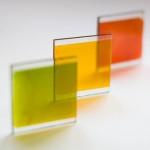Innovative New Form of Solar Glass Developed
A new form of 'solar glass' could be fitted to skyscrapers and tall buildings to enable them to generate their own electricity for IT and lighting systems.
 The innovative development is being tested by start-up company Oxford Photovoltaics, a spin off from Oxford University which set up in 2010. The company has managed to combine a dye-based thin film solar cell with glass substrates resulting in a tinted glass that also acts as a solar power generating system.
The innovative development is being tested by start-up company Oxford Photovoltaics, a spin off from Oxford University which set up in 2010. The company has managed to combine a dye-based thin film solar cell with glass substrates resulting in a tinted glass that also acts as a solar power generating system.
The technique involves screen printing metal oxides, dyes, plastics and polymers directly on to glass. The light reacts with the dye and creates a current that is collected through two terminals like a battery. The glass can be any colour and can even be opaque, thus providing a range of options for architects and builders.
Chief Executive of the company, Kevin Arthur, recently visited San Francisco in a bid to raise around £3.5 million in venture capital funding. The company hopes to complete its funding round later this year and would like to have its first batch of solar glass panels commercially available by the third quarter of 2013.
"We want to move to a full scale pilot production line that can make panels that are two metres by three metres,” he says. “We are under a lot of pressure from architects. They love this idea and are asking us to go faster."
Arthur believes that solar glass panels could undercut conventional solar panels on price, and sees a time in the near future when solar PV technology could function without the current assistance from subsidies.
“There are a lot of cost advantages to thin film solar technologies,” he says. “Because you are basically screen printing, production costs are much lower than for conventional solar cells and the cost of the materials is also falling. But most importantly once a company has decided to have a glass façade on their building they have already decided to install our substrate.”
At the moment thin film solar cells have much lower rates of conversion efficiency than standard solar technology. However, Arthur predicts that solar glass panels will one day be able to offer conversion efficiencies of 20 percent.
“Figures from architects show that 60 per cent of many modern commercial buildings’ surface area is glass" he says. “We have modelled the effect of the solar glass on a 700 foot skyscraper in Texas and it revealed that we could generate up to 5.3MWh a day. That’s enough to power 52,000 iPads. If you combined the solar glass with the installation of LED lighting in the building you could power all your lights, as well as DC powered devices such as laptops.”
Find local, MSC certified Solar Installers
Start your quote
Find local, MSC certified Solar Installers












